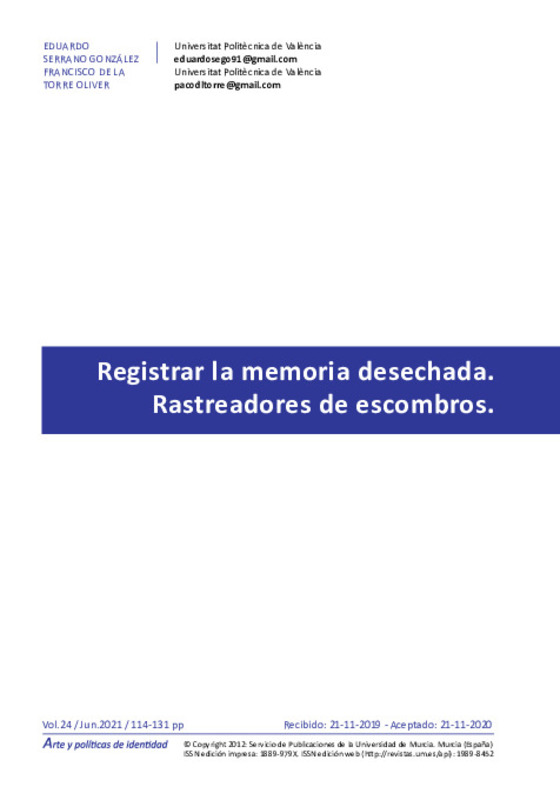JavaScript is disabled for your browser. Some features of this site may not work without it.
Buscar en RiuNet
Listar
Mi cuenta
Estadísticas
Ayuda RiuNet
Admin. UPV
Registrar la memoria desechada. Rastreadores de escombros
Mostrar el registro sencillo del ítem
Ficheros en el ítem
| dc.contributor.author | Serrano González, Eduardo
|
es_ES |
| dc.contributor.author | Torre Oliver, Francisco José de la
|
es_ES |
| dc.date.accessioned | 2022-11-16T19:01:14Z | |
| dc.date.available | 2022-11-16T19:01:14Z | |
| dc.date.issued | 2021-06-28 | es_ES |
| dc.identifier.issn | 1889-979X | es_ES |
| dc.identifier.uri | http://hdl.handle.net/10251/189820 | |
| dc.description.abstract | [ES] El presente trabajo analiza cómo la sociedad de consumo contemporánea transforma la ciudad en productora de desechos de memoria abandonados, y cómo estos objetos protagonizan el archivo fotográfico en redes sociales de los denominados rastreadores de desechos. Un fenómeno que estaría cuestionando la construcción de la memoria colectiva desde nuevas perspectivas. Tras esta observación, planteamos afrontar el análisis del objeto desechado como metáfora de la memoria mediante una posible analogía entre estos rastreadores urbanos y el Ángel de la historia de Walter Benjamin. Del mismo modo, vincularemos este fenómeno al cambio de paradigma de lo fotografiable, motivado en gran medida por la popularización de la cámara integrada en dispositivos móviles y las aplicaciones para compartir imágenes. Finalmente, en base a estas claves analizaremos una serie de cuentas en redes sociales donde sus autores desarrollan discursos artísticos alternativos. | es_ES |
| dc.description.abstract | [EN] The present work analyzes how the contemporary consumer society transforms the city into a producer of abandoned memory waste, and how these objects star in the photographic archive on social networks of the so-called waste trackers. A phenomenon that would be questioning the construction of collective memory from new perspectives. After this observation, we propose to face the analysis of the discarded object as a metaphor for memory by means of a possible analogy between these urban trackers and the Angel of Walter Benjamin¿s story. In the same way, we will link this phenomenon to the paradigm shift of what can be photographed, largely motivated by the popularization of the integrated camera on mobile devices and image sharing applications. Finally, based on these keys, we will analyze a series of accounts on social networks where their authors develop alternative artistic discourses. | es_ES |
| dc.language | Español | es_ES |
| dc.publisher | Universidad de Murcia | es_ES |
| dc.relation.ispartof | Arte y Políticas de Identidad | es_ES |
| dc.rights | Reconocimiento - No comercial - Sin obra derivada (by-nc-nd) | es_ES |
| dc.subject | Fotografía | es_ES |
| dc.subject | Abandono | es_ES |
| dc.subject | Objeto | es_ES |
| dc.subject | Memoria | es_ES |
| dc.subject | Archivo | es_ES |
| dc.subject | Deshecho | es_ES |
| dc.subject | Photography | es_ES |
| dc.subject | Abandonment | es_ES |
| dc.subject | Object | es_ES |
| dc.subject | Memory | es_ES |
| dc.subject | Archive | es_ES |
| dc.subject | Scrap | es_ES |
| dc.subject.classification | PINTURA | es_ES |
| dc.title | Registrar la memoria desechada. Rastreadores de escombros | es_ES |
| dc.type | Artículo | es_ES |
| dc.identifier.doi | 10.6018/reapi.484771 | es_ES |
| dc.rights.accessRights | Abierto | es_ES |
| dc.contributor.affiliation | Universitat Politècnica de València. Facultad de Bellas Artes - Facultat de Belles Arts | es_ES |
| dc.description.bibliographicCitation | Serrano González, E.; Torre Oliver, FJDL. (2021). Registrar la memoria desechada. Rastreadores de escombros. Arte y Políticas de Identidad. 24:114-131. https://doi.org/10.6018/reapi.484771 | es_ES |
| dc.description.accrualMethod | S | es_ES |
| dc.relation.publisherversion | https://doi.org/10.6018/reapi.484771 | es_ES |
| dc.description.upvformatpinicio | 114 | es_ES |
| dc.description.upvformatpfin | 131 | es_ES |
| dc.type.version | info:eu-repo/semantics/publishedVersion | es_ES |
| dc.description.volume | 24 | es_ES |
| dc.relation.pasarela | S\441315 | es_ES |








